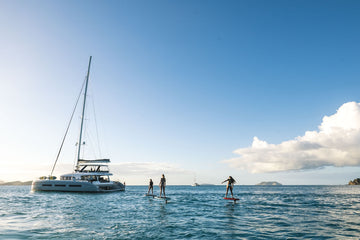If you’ve been captivated by the futuristic allure of eFoiling, you might be wondering: “How hard is it to ride an eFoil?” The short answer? It’s easier than you might think, but like any new sport, it does take a bit of practice to master. At Pura Vida Foils, we’ve seen riders of all skill levels—from total beginners to seasoned surfers—find their footing on an eFoil. Let’s dive into what makes eFoiling accessible, what challenges you might face, and how you can learn to fly above the water in no time.
What Makes eFoiling Easier Than It Looks?
At first glance, eFoiling might look like it belongs in a sci-fi movie, and you may assume it’s as hard as flying an actual spaceship. But the truth is, eFoils are designed to be user-friendly, making them accessible for riders of all ages and skill levels. Here’s why:
-
Stable Design:
eFoil boards are built to provide excellent stability, even at lower speeds. The wide and buoyant design of the board helps beginners find their balance easily. -
Remote-Controlled Speed:
The handheld remote gives you full control over the speed of the eFoil. You can start slow and gradually increase your pace as you gain confidence. Unlike surfing or wakeboarding, you’re not reliant on waves or a boat to move—you’re fully in charge. -
No Need for Waves or Wind:
One of the biggest challenges of traditional surfing or kiteboarding is relying on unpredictable weather or water conditions. With an eFoil, you can ride on calm, flat water, which makes learning much simpler. -
Progressive Learning Curve:
eFoiling allows you to progress at your own pace. Start by lying or kneeling on the board, then work your way up to standing and eventually "flying" above the water.
How Difficult Is It for Beginners?
For complete beginners, the hardest part of eFoiling is learning to balance on the board while controlling the speed. The good news is that most riders pick it up much faster than they expect. Here’s what you can expect during your first session:
-
Initial Learning Curve:
- Most beginners need 10-20 minutes to get comfortable with the board and the remote control.
- Balancing while the board is in the water is relatively easy, and you’ll start by riding in a lying or kneeling position to get a feel for the motion.
-
Standing Up:
- Standing up is the most challenging part for most new riders, as it requires a bit of coordination and balance. However, with guidance from an instructor and a few attempts, most people can stand within their first session.
- The trick is to keep your knees slightly bent, your weight centered, and your movements smooth and controlled.
-
Flying Above the Water:
- Once you’ve mastered standing and riding at low speeds, you’ll learn how to shift your weight to lift the board out of the water. This is the magical moment when you start “flying” on the hydrofoil!
- It may take a few sessions to get comfortable flying consistently, but the exhilaration is worth the effort.
What Challenges Might You Face?
Like any new sport, eFoiling comes with its own set of challenges. Here are some common hurdles and how to overcome them:
-
Balancing While Standing:
- Challenge: Finding the right balance can be tricky at first, especially when you’re transitioning from kneeling to standing.
- Solution: Start slow and focus on small, controlled movements. Practice shifting your weight gradually rather than making sudden adjustments.
-
Mastering the Remote Control:
- Challenge: Learning to control your speed with the handheld remote can feel overwhelming at first.
- Solution: Spend time practicing at low speeds to get a feel for the throttle. Once you’re comfortable, gradually increase your speed.
-
Falling Off the Board:
- Challenge: You’re likely to fall a few times while learning, especially as you practice standing or flying.
- Solution: Don’t worry—falling is part of the learning process! eFoils are designed to stop automatically when you fall, so you can safely climb back on and try again.
How Long Does It Take to Learn?
The time it takes to learn eFoiling depends on your previous experience with water sports, your balance, and how quickly you pick up new skills. Here’s a general timeline based on our experience at Pura Vida Foils:
- First Session: Most people can kneel or stand and ride at slow speeds within their first 1-2 hour session.
- Second Session: By your second session, you’ll likely feel more comfortable standing and starting to lift the board out of the water.
- Third Session and Beyond: After a few sessions, you’ll have the confidence to fly consistently and even try out some basic maneuvers like turning and carving.
For riders with prior experience in surfing, snowboarding, or skateboarding, the learning curve may be even faster.
How Can Lessons Help?
If you’re worried about the difficulty of eFoiling, taking a lesson with a qualified instructor is the best way to get started. At Pura Vida Foils, we tailor our lessons to your skill level, ensuring a smooth and enjoyable experience. Our instructors will:
- Teach you the basics of operating the eFoil.
- Provide tips on balancing, standing, and flying.
- Guide you through the learning process step by step, so you can progress at your own pace.
Final Thoughts: Is eFoiling Difficult?
While eFoiling has a slight learning curve, it’s much easier to pick up than many people expect. With its stable design, controllable speed, and beginner-friendly features, eFoiling is accessible to almost anyone willing to give it a try. The key is to start slow, stay patient, and enjoy the process of learning.
Ready to find out for yourself? Book an eFoil lesson or tour with Pura Vida Foils today, and experience the thrill of flying above the water. Trust us—once you get the hang of it, you’ll be hooked!







